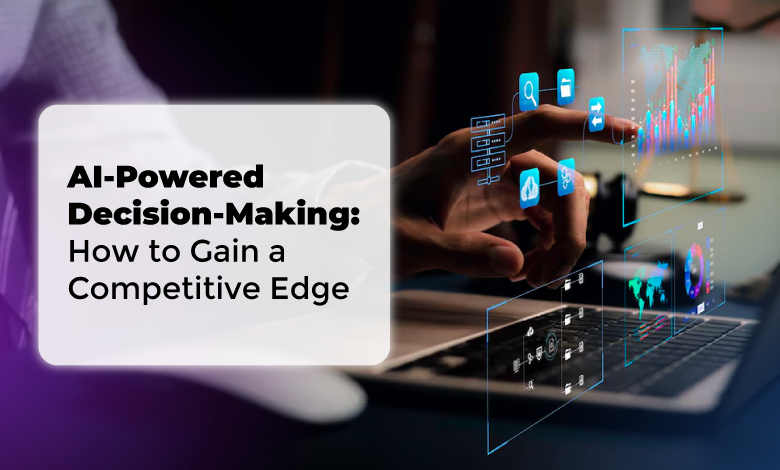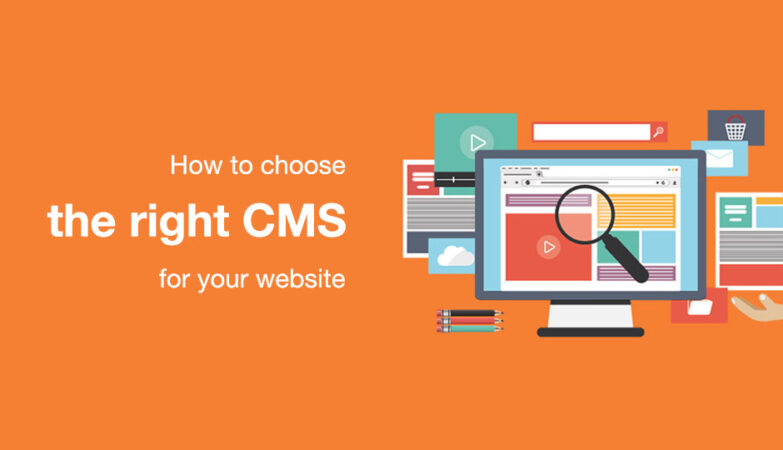What if your business could consistently make smarter, faster decisions without much hassle? Seems unrealistic? Well, with AI-powered decision-making, it’s a reality. AI is changing how businesses operate. It is helping leaders explore opportunities, combat challenges, and make data-driven choices that drive success.
By choosing AI-driven innovation and growth, companies can tap into predictive analytics, gain actionable insights, and beat competitors easily. Whether optimizing operations, predicting customer needs, or building effective strategies, AI-powered decision-making is the key to thriving. Ready to lead the way?
Understanding AI-powered Decision-making
AI-powered decision-making means using artificial intelligence (AI) to analyze data and find patterns to automate decision-making. AI tools process large amounts of information quickly and provide useful insights to help businesses make smarter and faster choices.
For example, AI can predict what customers may want to buy, detect risks in financial transactions, or suggest ways to improve a supply chain. It helps companies make better decisions, saving time, reducing mistakes, and improving outcomes.
Benefits of AI in Decision-making
AI-powered decision-making is transforming how businesses operate. Here are the five key benefits to know about:
- Improved Accuracy
AI-powered decision-making enhances accuracy by analyzing vast amounts of data to detect patterns and trends that humans may miss. This eliminates guesswork and reduces errors. For instance, predictive analytics can help you identify fraudulent transactions or assess credit risks precisely in finance. It ensures reliable outcomes that are essential for critical operations.
- Faster Decision-Making
AI tools help process information in real time and thus accelerate decision-making. With predictive analytics, you can anticipate challenges and act quickly. For example, in supply chain management, AI can forecast delays or optimize routes instantly. It assists organizations in staying ahead of disruptions. This speed is crucial for businesses undergoing digital transformation in competitive markets.
- Enhanced Efficiency
AI drives digital transformation by automating tasks and simplifying processes. It boosts efficiency across departments, letting teams focus on important work. For example, AI-powered hiring tools in HR can quickly screen applications, while predictive analytics in logistics ensures smooth operations. These efficiencies save time and support long-term growth.
- Data-Driven Insights
AI converts raw information into meaningful conclusions and provides actionable and data-driven insights. Businesses can use these insights to make informed decisions and drive innovation. For example, AI in marketing can analyze customer behavior to customize campaigns, while in product development, it can identify market trends to shape new offerings. This level of intelligence is a game-changer for business innovation.
- Reduced Costs
Machine learning in businesses automates repetitive tasks, reducing labor costs and operational expenses. AI tools can handle routine tasks like customer service, inventory management, or marketing, allowing businesses to use their resources more effectively. These cost-saving solutions are key to many companies’ AI strategies.
Different Phases of AI Implementation in Decision-making
AI’s role in decision-making spans various levels. Each has some unique characteristics and implications. Here are the phases:
- Decision Support
This is the starting phase, during which AI acts as an assistant to human decision-makers. It analyzes large datasets, identifies patterns, and provides insights to support decisions. However, humans should make the final decisions.
- Example: AI analyzes consumer behavior and market trends, offering strategy suggestions while managers choose the best action.
This phase ensures decisions are data-driven while using human judgment for context and creativity.
- Decision Augmentation
In this phase, AI takes a more involved role, going beyond presenting data to suggesting specific options for action. It uses advanced analytics and predictive models to highlight choices that may not be immediately apparent to humans.
- Example: AI recommends tailored pricing strategies for different customer segments, reducing reliance on human intuition.
This approach boosts decision-making quality, offering various innovative solutions while keeping humans in control for final approvals.
- Decision Automation
AI autonomously makes routine, data-driven decisions without human intervention at the highest level. This phase focuses on repetitive and rule-based tasks. It allows employees to focus on strategic and creative activities.
- Example: AI automates inventory replenishment by tracking stock levels and sales trends.
While this phase maximizes efficiency and consistency, it’s crucial to maintain oversight to ensure decisions align with business objectives and ethical standards.
Key Use Cases of AI in Decision-making
AI can be applied in various industries to support decision-making. Here are some examples:
- Finance
- Detects fraud in real-time by analyzing transaction patterns.
- Assesses credit risk using predictive analytics.
- Automates investment decisions with AI-powered algorithms.
- Streamlines expense management and reporting.
- Supply Chain and Logistics
- Optimizes delivery routes to reduce costs and time.
- Predicts demand to prevent stockouts or overstocking.
- Monitors supplier performance for better decision-making.
- Enhances warehouse operations with AI-driven automation.
- Cybersecurity
- Identifies and prevents cyber threats with real-time monitoring.
- Detects anomalies in network activity to prevent breaches.
- Automates responses to phishing and malware attacks.
- Strengthens authentication with AI-powered biometrics.
- Marketing
- Personalizes campaigns based on customer behavior and preferences.
- Recommends products or services using AI algorithms.
- Optimizes ad targeting with data-driven insights.
- Predicts market trends for more effective strategies.
- Retail
- Analyzes shopper behavior to improve product recommendations.
- Optimizes pricing strategies dynamically with AI.
- Predicts sales trends to plan inventory and promotions.
- Enhances customer support with AI-powered chatbots.
How AI Creates a Competitive Edge?
AI plays an important role in helping businesses stand tall. Here is how AI creates a competitive edge:
- Gaining Insights Faster than Competitors
AI processes vast data quickly and efficiently, uncovering trends and opportunities you may miss. This speed allows companies to adapt to changes, identify new markets, and make smarter decisions before competitors catch up. Faster insights mean staying ahead in fast-moving industries where timing is critical.
- Delivering Better Customer Experiences
AI personalizes customer interactions by analyzing behavior, preferences, and past activity. It powers features like tailored product recommendations, real-time support through chatbots, and predictive solutions to customer needs. These enhancements make customers feel valued, improve their overall experience, and foster loyalty, giving businesses a strong advantage over competitors.
- Improving Decision-Making Across Teams
AI supports decision-making in various departments, such as marketing, supply chain, and HR, by providing accurate, data-driven insights. This ensures that decisions are consistent, well-informed, and aligned with business goals. By automating routine processes and enabling smarter choices, AI helps teams work more effectively, driving better outcomes across the organization.
- Innovating by Predicting Trends
AI uses predictive analytics to identify market trends and anticipate customer demands, giving businesses a head start on innovation. By understanding what customers will need next, companies can develop new products, services, or strategies ahead of the competition. This ability to innovate quickly and accurately is key to staying relevant in a rapidly evolving market.
Challenges in Implementing AI-Powered Decision-Making
While the benefits of AI in business decision-making are undeniable, implementing AI is not free from the challenges. Here are the common ones:
- Data Quality and Accessibility
AI needs high-quality and relevant data to work well. If the data is incomplete, inconsistent, or unstructured, it can lead to wrong insights and poor decisions. Gathering and combining data from different sources can also be tricky and time-consuming.
- Integration with Existing Systems
Integrating AI with old systems and workflows can be difficult. Many businesses face issues like outdated technology, system incompatibilities, and resistance to change, which slow down AI adoption.
- Cost and Resource Constraints
Implementing AI requires significant investment in tools, skilled professionals, and infrastructure. For smaller businesses, these costs can be a barrier, making it harder to compete with larger companies.
- Ethical and Bias Concerns
AI can reflect biases in the data it learns from, which may result in unfair or unethical decisions. Businesses must work to ensure AI decisions are transparent, fair, and accountable.
- Complexity of AI Models
Many complex AI systems work like “black boxes,” where it’s hard to understand how decisions are made. This lack of clarity can reduce trust and make it difficult for teams to rely on AI recommendations.
Best Practices for Using AI in Decision-Making
Using AI in business decision-making can drive growth and innovation when done right. Here are some best practices to get started:
- Start Small with Pilot Projects
Begin your AI journey with small, focused projects to test its impact. This approach allows you to understand AI’s value without large investments and helps refine your AI strategy as you scale.
- Use Clean and Relevant Data
AI relies on accurate data to deliver reliable insights. Ensure your data is clean, up-to-date, and relevant to the decisions you’re trying to make. High-quality data is the foundation of successful digital transformation.
- Collaborate with AI Experts or Partners
Working with experienced AI professionals or opting for AI/ML development service providers can help you implement the right solutions faster. Their expertise ensures that your AI tools align with your business goals and support business innovation effectively.
- Continuously Evaluate and Refine AI Models
AI models need regular updates to stay accurate and effective. Monitor their performance, gather feedback, and make adjustments as needed. This ongoing refinement ensures that your AI aligns with your evolving business needs.
- Ensure Transparency and Ethical Use of AI
Build trust by making AI decisions transparent and ensuring ethical practices. Clearly explain how AI systems work, avoid bias, and ensure accountability. Ethical AI builds confidence and supports long-term growth.
Tools and Technologies for AI-Powered Decision-Making
AI-powered decision-making relies on various tools and technologies to analyze data, generate insights, and automate processes. Here are some key categories and examples:
- Data Collection and Management Tools
Efficient decision-making starts with collecting, organizing, and managing high-quality data.
Examples:
- Apache Hadoop: For processing and storing large datasets.
- Snowflake: A cloud data platform for data warehousing and analytics.
- MongoDB: A NoSQL database for flexible and scalable data storage.
- Machine Learning Platforms
These platforms help build, train, and deploy machine learning models.
Examples:
- TensorFlow: An open-source framework for building ML models.
- PyTorch: A popular tool for deep learning and AI research.
- Google AI Platform: A cloud-based environment for developing ML solutions.
- AI-Powered Analytics Tools
AI analytics tools provide insights through data visualization, predictive analytics, and simulations.
Examples:
- Tableau: For interactive data visualization and analytics.
- Microsoft Power BI: A business intelligence tool for sharing insights across teams.
- RapidMiner: For predictive analytics and data science workflows.
- Natural Language Processing (NLP) Tools
NLP tools help analyze and understand unstructured text data.
Examples:
- IBM Watson NLP: For text analysis and extracting insights.
- spaCy: An open-source library for advanced NLP.
- Amazon Comprehend: A cloud-based NLP service.
- Automation and Workflow Tools
These tools streamline decision-making by automating repetitive tasks.
Examples:
- UiPath: A leading robotic process automation (RPA) tool.
- Zapier: For automating workflows across apps.
- Automation Anywhere: For scalable automation of business processes.
- Cloud AI Services
Cloud-based AI services make it easier to implement scalable AI solutions without heavy infrastructure investments.
Examples:
- Amazon Web Services (AWS) AI Services: AI tools for developers, like Amazon Rekognition and SageMaker.
- Google Cloud AI: Services for machine learning, NLP, and vision.
- Microsoft Azure AI: A suite of AI tools for vision, speech, and language.
- Decision Optimization Tools
These tools use algorithms to recommend the best courses of action based on various scenarios and constraints.
Examples:
- IBM Decision Optimization: For creating data-driven business models.
- FICO Xpress Optimization: For solving complex optimization problems.
Future Trends in AI for Decision-making
AI is becoming more advanced and easier to use, changing how businesses make decisions. Here are three important trends to watch:
- AI for Everyone with Low-Code/No-Code Platforms
Low-code and no-code tools make AI simple to use, even for people who don’t know programming. These platforms let teams create and use AI models quickly, making AI accessible to more people and boosting innovation across businesses.
- Clearer Explanations for AI Decisions
In the future, AI will provide clearer reasons behind its decisions. This will make it easier for people to understand and trust AI’s recommendations, especially in fields like healthcare and finance, where clear explanations are crucial.
- Generative AI for Business Planning
Generative AI, known for creating content, will help businesses plan smarter. It can analyze data, predict trends, and even suggest new ideas for strategies. Companies can use it to plan operations, develop products, and improve decision-making.
Final Thoughts
AI-powered decision-making is changing how businesses work, helping them make smarter and faster choices with data-driven insights. By using predictive analytics and machine learning, companies can find new opportunities, improve strategies, and stay ahead of the competition. A clear AI strategy ensures these tools effectively drive innovation and growth. Embracing AI today is essential for gaining a strong competitive edge.








